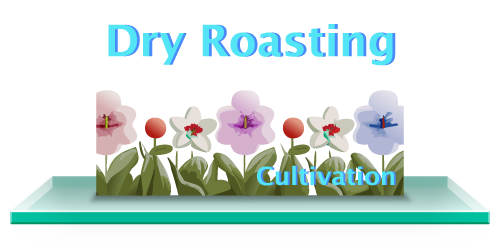The Dry Roasting Technique focuses on the raw material needed to develop a creative work in a chosen direction beginning with, and working out from, the initial Strategic Ideas.
 How does 'Dry Roasting' work?
How does 'Dry Roasting' work?
The Dry Roasting technique works on the essential ingredients required to develop a creative work from its initial conception and towards its defined objectives.
The intention of Dry Roasting is to help the creative mind find the wood behind the trees. The goal is to free the mind of needless detail and, in so doing, ensure that the basic structure of a creative narrative is both efficient and true.
Techniques such as IWWM and Why? Why? Why? are often harnessed to brainstorm ideas for the possible development of a narrative.
The idea of Dry Roasting, however, is to ensure that the narrative is true to its specific starting points and required objectives by separating out and working with only the purest ideas: those that are closest to the primary intention of the narrative.
 Illustration: Dry Roasting
Illustration: Dry Roasting
The following is an abridged example of the use of Dry Roasting in the development of Alteration and Adjustment? - a section from the story of The Tailor.
*****
Specific Idea guiding this section of the text:
The arrival of an assistant for the tailoring business, Threads of Arrow Street
*****
General Ideas generated from harnessing Glanside Cultivation Techniques:
- This is what Anjali should have expected.
- Why is Anjali's uncle keen that Threads has an assistant?
- What is her uncle's intentions in recommending Panya?
- How will the theme of the backcloth of tailoring be carried forward?
- Had Anjali been informed of Panya's possible intentions, she would have ignored the warning.
- Panya is the opposite of Anjali. Panya thrives on detail and completion of a defined task.
- Anjali is grateful for Panya's assistance, but the danger is already hidden in the text.
*****
Dry Roasting - determining the critical ingredients of this section:
- Anjali's visible agenda.
- Panya's agenda - a hidden agenda but hinted at.
- The sense that Anjali is being carried along by an ambition that dates to her earliest memories. This is important as it relates back to the metaphor of the unstoppable river.
- Anjali allows herself to be swept away. It is her choice not to keep hold of levers of the business.
*****
Refined General Ideas:
- Anjali has had no effective input on the appointment of her assistant.
- Panya mirrors the no-nonsense capability of Anjali's uncle.
- Anjali is assisted by the new assistant, but the support comes at a great cost.
- By encouraging Anjali to pursue her aspiration, Panya is removing her from control of the business.
- Because of the hold of her aspirations, Anjali overlooks the evidence of Panya's intentions.
- Both women are pursing an ambition, but Anjali's is creative and aspirational, whereas Panya's is coldly practical.
*****
Excerpt from a worked section of The Tailor developed from these Refined General Ideas:
Anjali's new assistant was entirely as her uncle had advertised. Anjali's new junior partner, Panya, quickly asserted herself, managing the varying workload and even finding two capable part-time assistants to cover weekly and annual business cycles: the windy weekends, the private functions, the festive celebrations, the parties of the early spring.
The pressure and worry displaced by Anjali's new and capable assistant provided further opportunity to design her own garments, rather than rescue the remnants of someone else's.
'I need to construct garments from a scribble on paper to the complete structure that enhances the human form and presence,' Anjali pitched to herself as she sat at the shop's kitchenette table, a tap dripping effortlessly in the background. 'Threads will not thrive unless we can offer a comprehensive tailoring service.'
This thought was attractive to Anjali and, being attractive, seemed correct.

